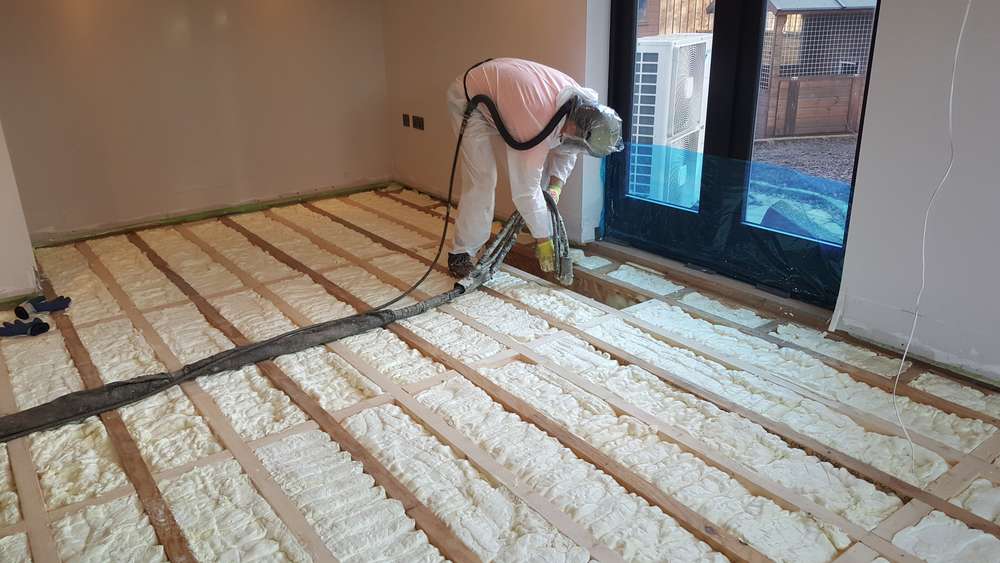Attic Spray Foam Insulation Mullagh
3 Bed Semi Attic Insulation Mullagh

Attic Insulation Mullagh
Spray foam works in many different conditions. Spray foam can be used on roofs, windows and attics as well underfloor heating systems and interior and external walls.
Spray foam insulation is not only warm and comfortable in winter but also cools your home in summer. Because of its “Cell” structure and composition, it allows moisture-laden air to escape. This helps the house breathe.
Benefits of Spray Foam Insulation for your home
Other applications include agricultural farm houses and commercial andindustrial buildings, sheds and shipping containers.
It also forms an airtight seal around your home to prevent rain and cold wind from entering. The heat will escape from your home, unlike other insulating items on the marketplace today.


Cost Price Of Spray Foam Insulation
Spray foam insulation has proven to be the most effective insulation material on the market today. It has a higher U value than other insulating materials such as rock wool, fiberglass and cellulose.
Spray foam insulation also works well as an sound barrier. Spray foam insulation significantly reduces noise from outside. It is a great advantage if a company or home is in a densely populated area or close to an airport.
Insulate Your Mullagh Property Properly
It’s commonly used to block sound from traveling between rooms or floors. It’s especially effective on bathroom walls because noises from flushing toilets or showers can make it a nuisance.
It is very easy to use and doesn’t cause any disruption to everyday life.
An Irish traditional home can be insulation in one day.
Encasing the pipes and insulation reduces noise coming from under-floor or in-wall piping.

Plan to store things in your loft or attic, so you’ll need to put boards on top of the joists. Insulation will not be thick enough if you insulate only between the joists.
It is much more effective than fibreglass, rock wool or polystyrene panels when used inside walls, roofs, floors and attics. Its dense composition, and its application process results in an envelope that is completely airtight. It blocks sound from outside, including traffic, pedestrianised streets, and areas near airports.
It also blocks sounds from a structure’s walls from reaching other floors, including the floors below. Spray foam insulation will dramatically reduce the sound levels of many noises within a structure, including talking, hair dryers (phones), office computers and printers as well as running showers, laundry machines, clothes dryers.
Spray foam insulation that is both flexible, and filled with millions and millions of air bubbles will absorb the vibrations of the floor. The floor’s wooden members and floor will also be affected. Spray foam insulation reduces airborne noise transmission by sealing all cracks and crevices.
Spray foam insulation is also effective in dampening, if no longer completely eliminating, any sounds that might be emanating from a floor like water running through pipes. It surrounds pipes securely, preventing them rattling. It also prevents hot water from flowing through the pipes, which can cause the wooded beams to creak, crackle and expand.
It also keeps heat from escaping to upper floors, which causes lower floors to become colder, which in turn makes them require more heat to keep warm. The upper floors become too hot.
If your loft is easily accessible and does not have condensation problems, insulation should be straightforward.
Uninsulated homes lose 25% of their heat through their roofs. Insulating your roof, attic, and loft is a good way to reduce heat loss. It will also reduce your heating bill.
Rolls of mineral wool insulation can be used if access is good and the loft joists have regular dimensions. The insulation is first laid between the horizontal beams, or joists, that make up the loft floor. Next, another layer is laid at right angles so the insulation can be covered to the desired depth.
In order to have enough insulation, raise the floor so that enough mineral wool can be fitted below the new floor. You can either fit timber battens between the joists or buy plastic legs that are specifically designed to fit the joists. To prevent condensation from forming on the boards’ undersides, it is important to ventilate the air gap between insulation and boards.
You should not squash the mineral wool while you place the boards on top. This will decrease its insulation value.
Insulation prevents heat from escaping living spaces. It will make loft space more comfortable and less humid. This could lead to dampening or worsening existing condensation or damp problems. Consider increasing ventilation if you’re installing loft insulation by yourself.
Another way to insulate your loft would be to place insulation between and above the rafters. These are sloping timbers which make up the roof. You have two options: rigid insulation boards that are carefully cut to your specifications or foam insulation spray between the rafters.
Some companies will offer to spray insulation directly on the roof, without having to first fix the problem. We don’t recommend this. Like any type of insulation you should ensure that your roof is in good repair before adding insulation.
You can use your loft to heat the space, but you will need to create a separate room on the roof.
If you’re planning on using your loft as a living room, or it’s being used already, make sure all walls and ceilings that divide a heated and unheated space have insulation.
The air needs to move freely through your house in order to keep it fresh, dry and healthy. A professional installer will ensure that your house does not have any obstructions or seals. Do not cover any grilles, vents, or airbricks if you do DIY insulation.
You can have blown insulation installed if your loft is difficult to access. A professional will use specialist equipment and blow the right insulation material into every space. They may use mineral wool fibres, treated cellulose foam or polyurethane.
Flat roof insulation may save you the same amount as loft insulation on your heating bills. The cost savings will depend on the size of the flat roof.
If your loft is easily accessible, doesn’t have damp problems, and has a flat roof, it could be insulate yourself. If there are damp issues or more complex insulation needs, a professional should be hired.
Your loft hatch could become colder due to the cooler air. This can be prevented by installing an insulated hatch in your loft and putting strips of draught-exclusion material around the hatch edges.
Insulating your ground floor can help you keep your home warm and reduce your carbon footprint.
Insulating a loft is an effective way to lower heating bills, be more efficient and warm your home in the winter. Even if your loft already has insulation, you need to ensure that it is effective.
Loft floor rolls – These are the classic option. They are laid along the loft’s floor. They are less difficult to lay than insulated boards. They are available in loose and encapsulated rolls (blanket) and can be used for both top and bottom layers. To create a storage platform, they can be boarded using stilts.
These tips and recommendations aren’t listed in this article’s tool and material list. It is important to make sure that you have all the information you need before you start insulation your loft floor.
Although insulation is present in many homes, it might not be as effective as you would like. This could be due to insulation being compressed by storage boards placed over it or if it hasn’t been topped up in the long-term. In some older properties, the loft floor may only be 25mm deep.
It doesn’t have to be removed from your loft floor insulation. To achieve the recommended amount, you can just add one or several layers to it. You will find more information about the recommended amount in the article.
Your loft floor’s joint spacings will affect the width of the roll. This is due to the insulation being rolled between these beams. We recommend you select one that’s close to the spacing of your joists. This minimizes the need to trim.
The insulation’s required thermal resistance. Alternativly, you can measure the insulation’s thickness if you are only laying loft rolls. For more information, see the section ‘How do I calculate the thickness of loft floor insulation?
Areas We Service


Parkhill, Dublin
01 5255297

